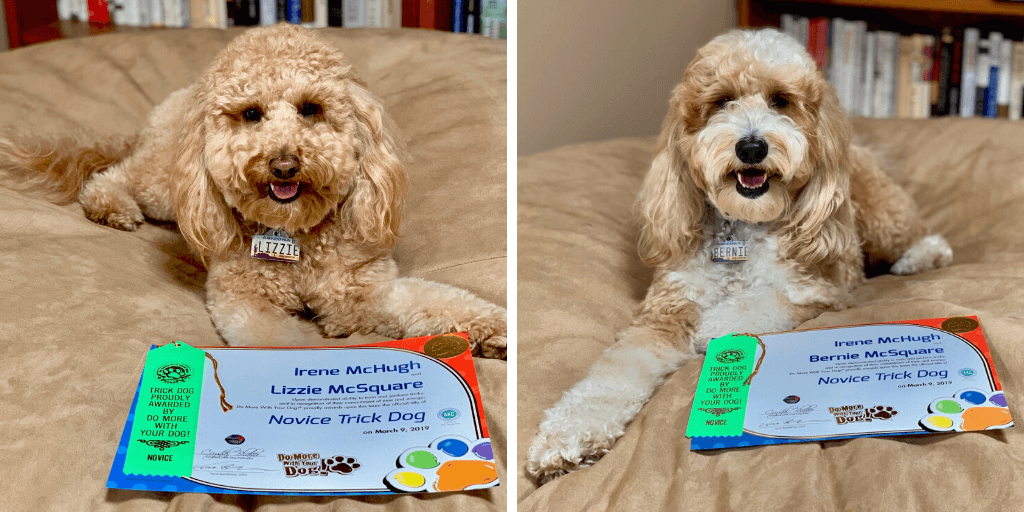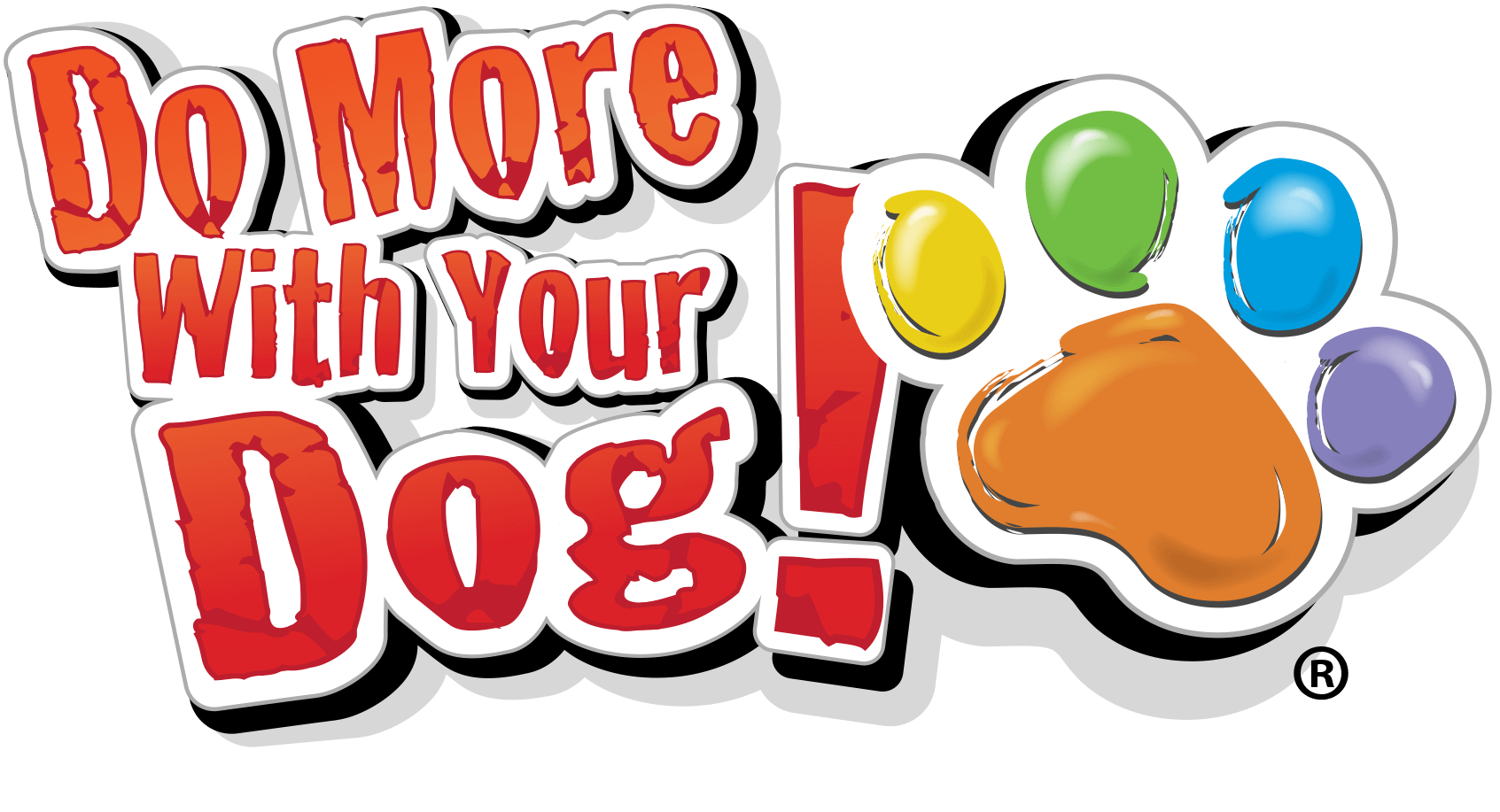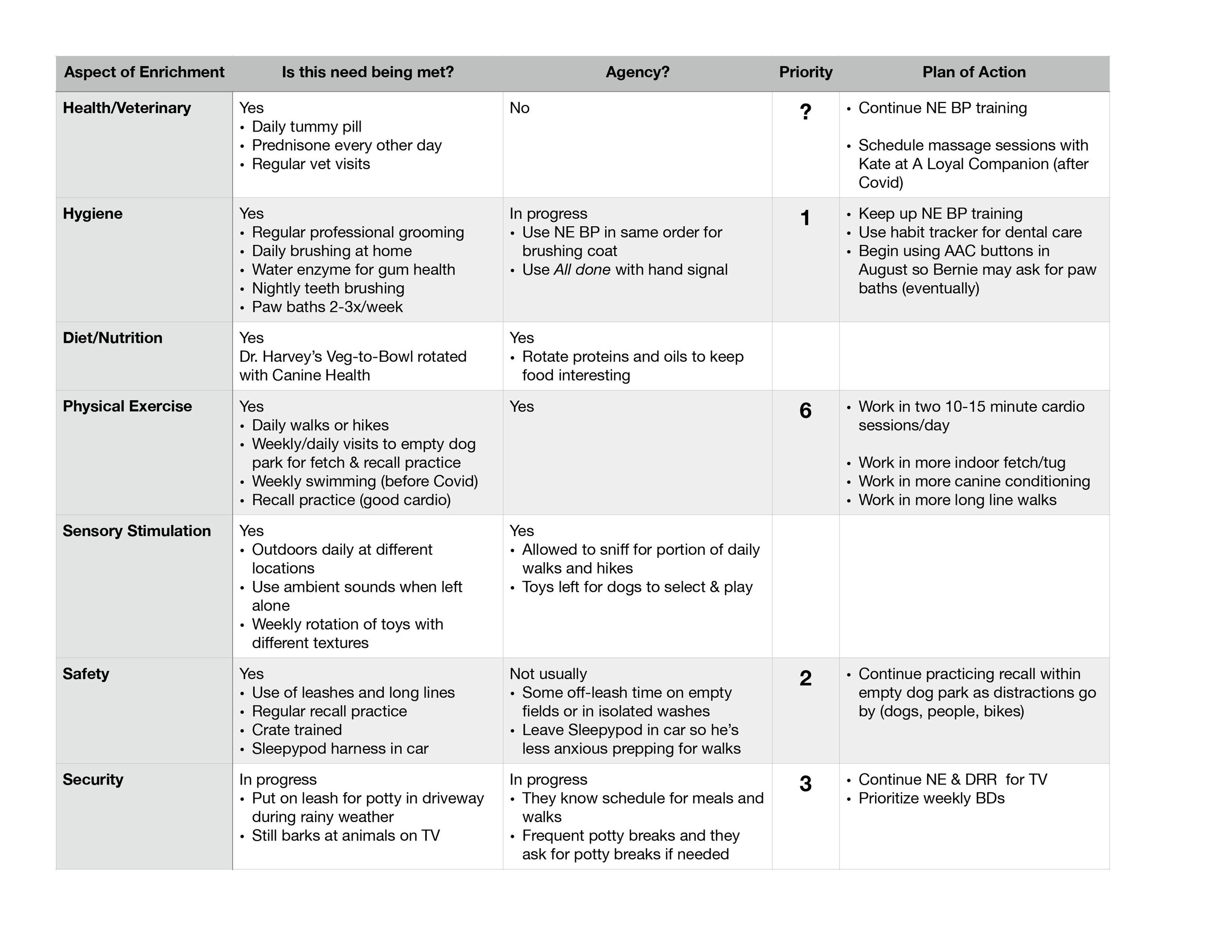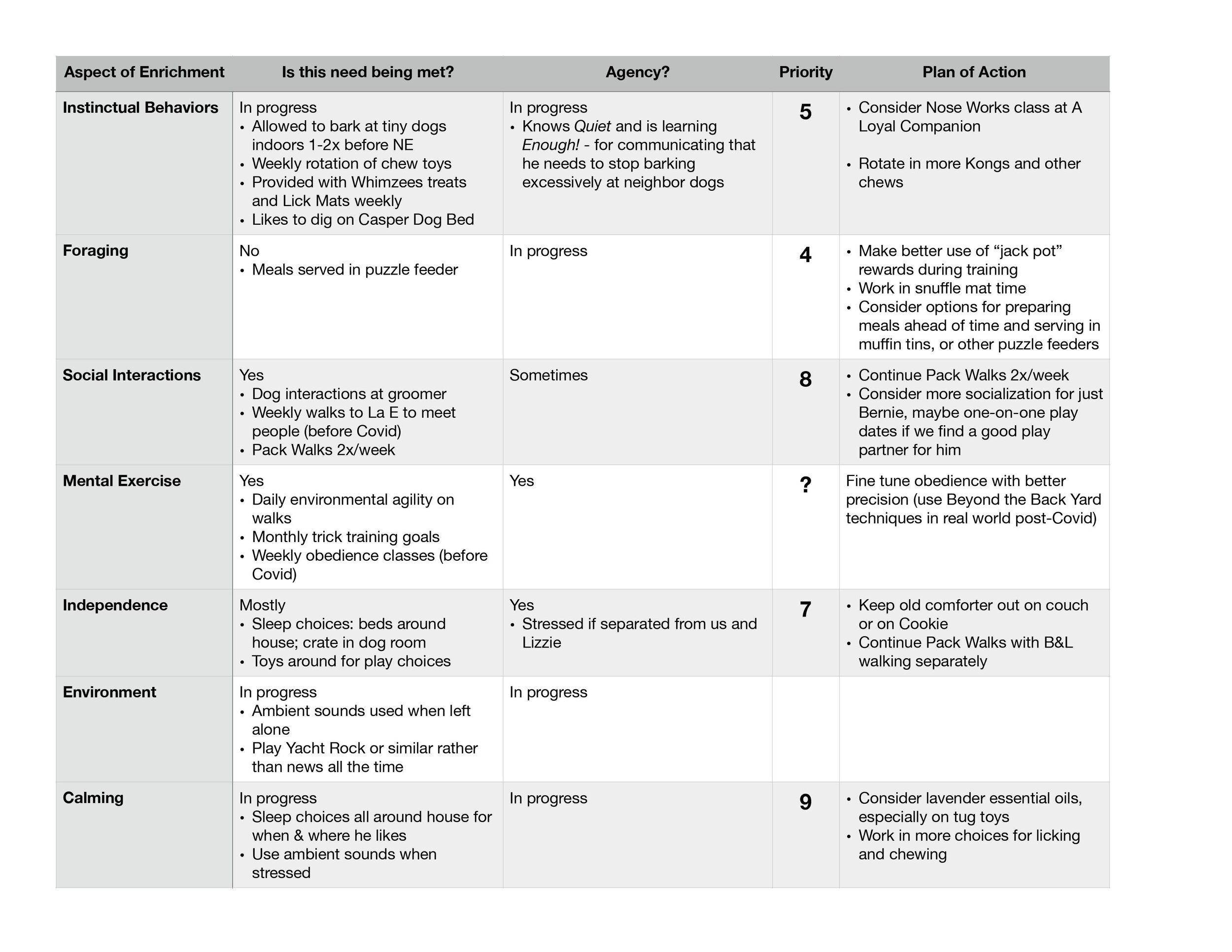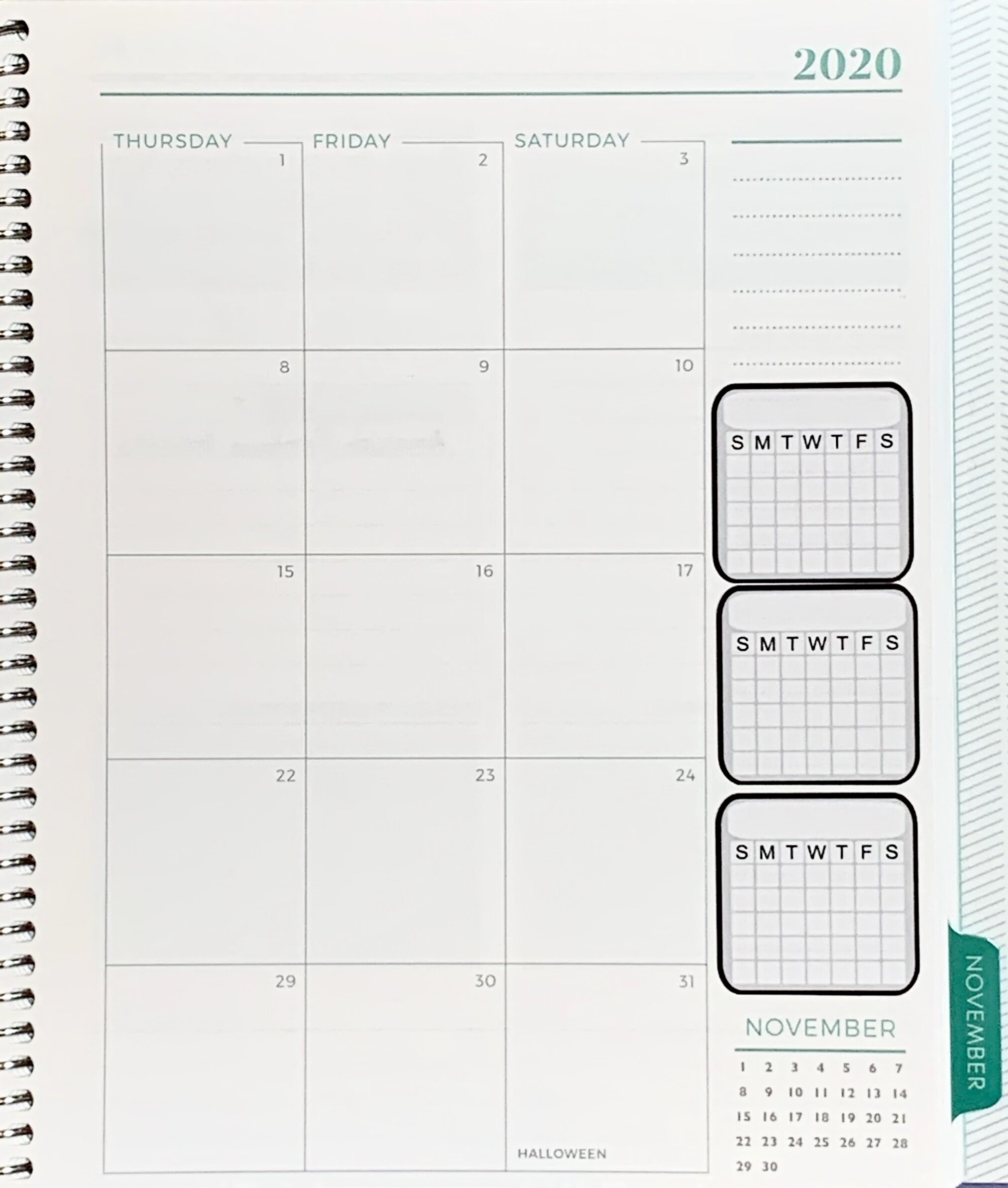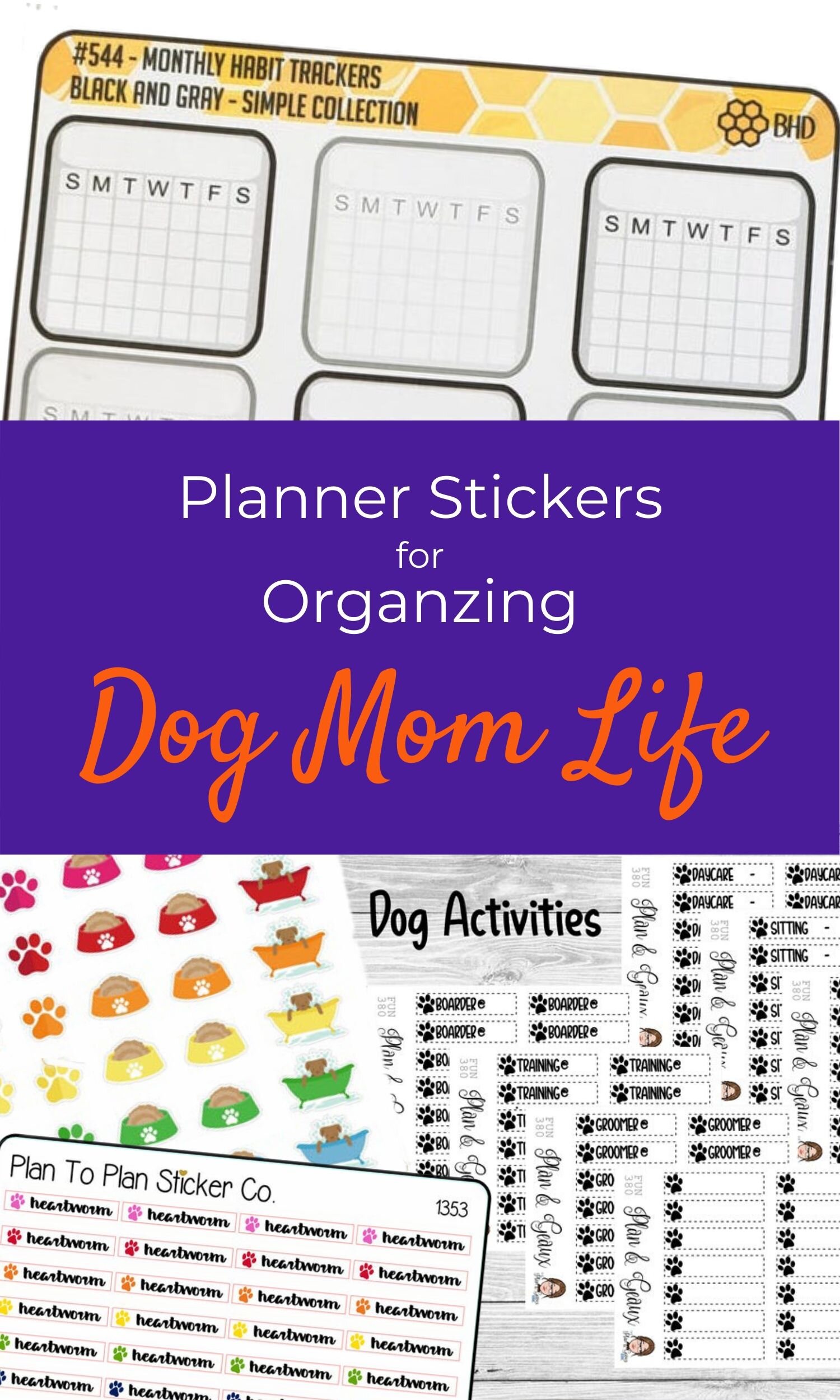Improve Your Dog's Life with a Complete Enrichment Plan
/You’ve seen those blog posts about canine enrichment activities. You’ve watched videos about indoor games you can play with your dog. You keep a running list of healthy treats for stuffing a Kong.
All of this inspiration is great, but how do you ensure that you’re regularly meeting your dog’ needs to help him live his best doggy life?
You need a plan.
Specifically, you need a canine enrichment plan.
Earlier this year authors Allie Bender and Emily Strong blew me away with their well-researched meticulous book about canine enrichment. In my full review of Canine Enrichment for the Real World: Making it a Part of Your Dog’s Daily Life, I broke down how the book’s organization helps responsible dog parents reflect upon how they’re meeting their dog’s needs and how they might improve upon what they’re already doing.
I shared some of my thoughts about creating enrichment plans for Bernie and Lizzie within my book review, and in April 2020, I wrote my first canine enrichment plan using the formatting they suggest from their book.
Here are my suggestions for you to write your canine enrichment plan.
This post may contain affiliate links, which means at no additional cost to you, I may earn a small commission if you click through and purchase something. Please see my Affiliate Link Disclosure policy for more details.
Use the book to guide creating your canine enrichment plan
Step 1: Purchase
Step 2: Start with some solid brainstorming as you read.
As I read Canine Enrichment for the Real World, I was highlighting all the things I was already doing, and all the things I wanted to do. I would advise making your life easier by highlighting these two categories with two different colors. If you prefer marking passages with post-it flags, then two different colors would still be helpful.
Step 3: Make a master list of ideas tailored for you and your dog.
Evernote is my go-to digital filing cabinet, but you could create your master list wherever you like, even in a paper notebook. I prefer digital because I can access my list whenever I hear or read a great enrichment suggestion. Also, organizing a digital list means easily inserting new details, and copying/pasting other information.
If you’re going to follow the canine enrichment template from the book, then I would suggest breaking your ideas into the same 14 categories. You may not think you have ideas for all 14, but as you brainstorm, write, and reflect, you’ll probably surprise yourself.
Health/Veterinary
Hygiene
Diet/Nutrition
Physical Exercise
Sensory Stimulation
Safety
Security
Instinctual Behaviors
Foraging
Social Interactions
Mental Exercise
Independence
Environment
Calming
A few specific suggestions for organizing your enrichment ideas:
Don’t edit yourself. Even if you have an enrichment idea that seems impossible, add it to your master list. Your dog may not be ready for your pie-in-the-sky idea right now, but by implementing, reflecting upon, and revising your enrichment plan, your dog could work up to that idea. And if you know that your dog would love doing X activity, write it down.
For any of the categories, make a running list of any items you’d like to buy, even if it’s just a mental list. Whether you’re searching through thrift store items, shopping locally or online, having a list of items that will make your dog’s life richer will be a helpful reference.
Within physical exercise, make a list of the hikes you want to take with your dog, and all the places you want to visit with him. I keep a list of area parks/shared paths handy so we’re always rotating our walking destinations. Don’t lose any inspiring ideas!
Within mental exercise, list the dog sports, activities, or classes that you want to try with your dog. If you’re not sure where to start, consider tricks training. For many novice tricks, there’s little equipment to buy unless you choose tricks involving props.
Step 4: Grab Allie and Emily’s Enrichment Chart Guide from their website Pet Harmony.
I just found this enrichment chart guide, so I’ll be using it as I revise my plan. I signed up for their email list, and so far I’ve received what seems like an introductory set of 5 emails from them. They spread the emails out so I would get one every three days.
All of these emails had helpful ideas and resources. They were also pretty short and/or skimmable. One of the emails even gives a case study example of an enrichment plan used to address counter-surfing.
Now I receive one email per week that usually highlights the content of their weekly blog post.
Step 5: Join their Enrichment for the Real World Community private group on Facebook.
I found Allie and Emily’s Facebook group at the same time I found their enrichment chart guide, so I’m pretty new to the group. What I can report so far is that activity is brewing. They clearly have plans for the group, they’re adding moderators, and I’m excited to be a part of a community where other dog parents will support one another with our enrichment plans.
Maybe I’ll see you in the group!
Write your canine enrichment plan
Step 6: Decide how you want to approach your first plan.
For my first canine enrichment plan, I did not list any concerning and desirable behaviors. I just jumped in writing a catch-all plan. Basically, I was assessing my ability to meet Bernie & Lizzie’s needs within the 14 categories.
However, if you wanted to address undesirable behaviors, then you could write a canine enrichment plan that helps you identify what might be causing or triggering that behavior. Getting feedback in the Enrichment for the Real World Facebook group would certainly be helpful.
Once you think you’ve identified what might be leading to undesirable behavior, you can brainstorm a few ideas for what you could implement. Choose one of those ideas to try out for a few weeks. See how your dog responds, and then update your canine enrichment plan.
For my first plan, I wanted to see where my obvious gaps were. I quickly saw that meeting their foraging needs was a challenge for us. We feed Dr. Harvey’s Dehydrated Base Mix. We like controlling the protein sources and oils that our dogs eat. But that means I’ll need to get a bit more creative with muffin tins and other puzzle feeders, and potentially prepare their meals in advance to freeze them.
Even with obvious gaps, I did think about Bernie and Lizzie’s individual behavior and prioritized my plan of action to address their needs.
With Bernie, I’m always thinking about how anxious he may or may not be. When I see him licking his paws, I try to figure out if he just needs a paw bath, or if something else is adding stress to his life.
I updated the first canine enrichment plan for Bernie below to reflect how our life has changed during the Covid-19 pandemic. There are certain activities that we’re no longer participating in. Combine social distancing with Arizona summer heat, and I’m implementing much more indoors enrichment.
Step 7: Give yourself at least 30 minutes to write your first canine enrichment plan.
If you set up your own template for your plan, be sure to save a blank template.
I think it took me about an hour to write the two plans for Bernie and Lizzie. After making my template, I just brain dumped everything I could think of that we do to make Bernie and Lizzie’s lives better.
Since my first plan was written to give myself an overview of what Matthew and I are doing right and where we can improve, I did copy and paste quite a bit.
Step 8: Keep the document easily accessible for quick adds.
I minimized the spreadsheet on my desktop, so that as I remembered things, I could pop them into the plan. I was adding details to the document here and there for about a week to ten days.
As an example, even after sending the first draft to our trainer for feedback, I realized that I had forgotten to add paw baths to our hygiene row. The first time I started to run water for a paw bath, I ran over to my computer and made that addition.
As you go through your daily and weekly routines with your dog, you’ll realize what details you’ve missed. If you can’t get to the actual canine enrichment plan document right away, then have some other way to capture your idea so you don’t forget to add it in.
Reflect on your canine enrichment plan
Step 9: Ask for feedback.
I asked our dog trainer for feedback on the plans I wrote for Bernie and Lizzie, but with the Enrichment for the Real World Community on Facebook, I anticipate that I could look for inspiration and ask for feedback there as well.
If you’ve got another dog loving friend who gets as excited as you do about their dog, ask them to look over your canine enrichment plan. Who knows what suggestions they may have.
Step 10: Decide how often you want to revisit your canine enrichment plan.
Based on what I’ve read so far about canine enrichment plans, you can revise their implementation as often as you see a need or are comfortable.
My original plan was to revisit my plans in six months. Now that I’m a member of the Enrichment for the Real World Community on Facebook, I may decide to revise my plans more frequently.
But that’s just another thing I love about these enrichment plans. They’re as flexible as you want to make them. No one is looking for perfection or suggesting that perfection is even the goal. The goal is to find those enrichment activities and opportunities that improve the life of your dog without stressing you out.
Step 11: Consider how you’ll track your progress with your plan.
On this first canine enrichment plan, I was also considering how I would implement changes that I would be successful with.
About a year ago, I quit using digital planning tools like Trello and Things. Switching to a paper planner has helped me track my daily habits much more accurately.
I use Plum Paper Planners because of their personalization options. Not only can I add a photo of my two Doodlebutts on the cover, I can customize the text on every section of the daily planner layout. I labeled one of the boxes “Dog Training & Enrichment” so that every day, I track the activities we complete.
On the monthly calendar pages, I add three habit trackers.
One of them is for tracking how often I’m brushing Bernie and Lizzie’s teeth each night. Some months I do really well with keeping up with their dental care. Other months I struggle. The habit tracker is an easy visual for me to scan and assess how I’m doing month-to-month.
The other two habit trackers are for tracking our tricks training. Sometimes both of these habit trackers are for two new tricks we’re working on that month. Other times, I use one habit tracker for a new trick and the other for a trick we’re refining.
If using a planner doesn’t appeal to you, then you could create a one-page list of enrichment ideas that you could check off each week as you complete them.
Print the list on bright card stock.
Be sure to include large check boxes for each activity or idea.
Laminate the checklist or place it in a clear sheet protector.
Leave the list somewhere where you’ll see it every day. Maybe on your refrigerator, or near your dog’s feeding bowls.
Use dry erase markers to check off each enrichment activity you complete.
At the end of the week, use water or vinegar to wipe your list clean and be ready for next week.
Do canine enrichment plans really help?
Ours has certainly helped us!
I wrote our first canine enrichment plan in April 2020. That was three months ago. While I have added more enrichment activities, I’ve also really learned to consider how much agency we give Bernie and Lizzie.
Here’s one small adjustment I made that completely changed Bernie’s perception of daily walks.
After I completed Bernie and Lizzie’s two canine enrichment plans, I sent them to our dog trainer for feedback. She gave me some great ideas for integrating training protocols that she knows I already know, but I had left them out of the bigger plan. She also pointed out under “Safety” that whenever we travel with Bernie and Lizzie, they’re secured in their Sleepypod harnesses.
How I forgot about the Sleepypod harnesses, I don’t know. But our dog trainer’s comments on the enrichment plan got me thinking more about how Bernie interacts with his car safety harness.
Sadly, Bernie is not a fan of harness. And that’s not Sleepypod’s fault. He really doesn’t like any harness or clothing around him. We tried using a harness when he was a puppy, and even with a slow thoughtful introduction to each paw being threaded through different kinds of harnesses, Bernie rejected each one.
And by rejected, I do mean that he would walk around awkwardly with a bit of a hump back stilt. I tried putting jammies on him once, and I got the same reaction. Our boy wants to be free.
So how does this reflection tie into the canine enrichment plan, you might be wondering?
I realized that Bernie’s excitement for anticipating walks got cut short every time because I was putting his Sleepypod harness on indoors. I always put his leash on first. I could see how happy he would be knowing that adventure awaited. But as soon as I would reach for the harness, he would shrink away.
Knowing more about agency, and seeing this reaction just made me sad for our guy. I want him to get excited about going for walks.
It finally dawned on me that I could leave the Sleepypod harnesses for both dogs in the car.
From my observations, this small change has meant the world to Bernie. I see our Doodle boy smiling at me every time I put his leash on. He walks confidently to the garage with a spring in his step, and hops into the car joyfully.
When it’s his turn to have the Sleepypod harness adjusted around him, he does seem to still kind of groan. He gets this look on his face like “Fine, mom, if you insist,” but once we start driving, he happily moves from sitting up to lying down next to his sister on the backseat.
We’ve been leaving the Sleepypod harness in the car for several months now. Bernie knows that he’s expected to wear the harness in the car, but he also knows that’s the only place I expect him to wear the harness.
If I had not completed our two canine enrichment plans, I don’t know that I would ever have had this revelation. So revisiting and revising our canine enrichment plan is worth the time and effort as far as I’m concerned.
Bernie and Lizzie are family. We want them to live their best lives. If canine enrichment plans help me adjust goals for improving their lives, then I’m all in.



